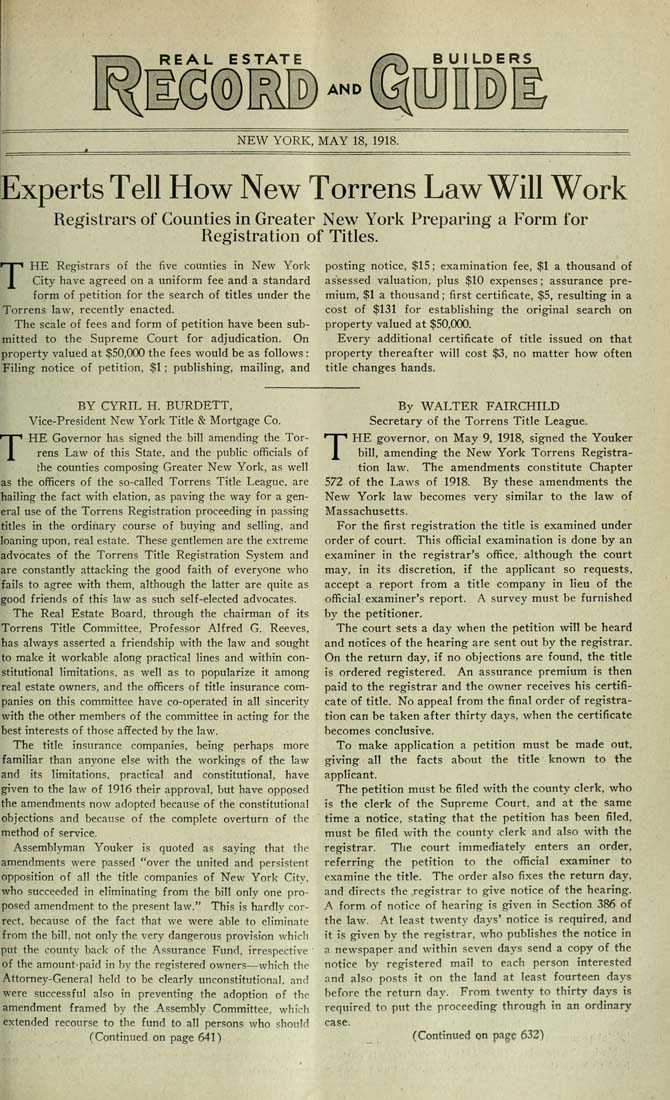Columbia University Libraries Digital Collections: The Real Estate Record
Use your browser's Print function to print these pages.
Real estate record and builders' guide: [v. 101, no. 2618: Articles]: May 18, 1918

Text version:
Please note: this text may be incomplete. For more information about this OCR, view About OCR text.
AND B UILDERS in© NEW YORK, MAY 18, 1918. Experts Tell How New Torrens Law Will Work Registrars of Counties in Greater New York Preparing a Form for Registration of Titles. THE Registrars of the five counties in New York City have agreed on a uniform fee and a standard form of petition for the search of titles under the Torrens law, recently enacted. The scale of fees and form of petition have been sub¬ mitted to the Supreme Court for adjudication. On property valued at $50,000 the fees would be as follows: Filing- notice of petition, $1; publishing, mailing, and BY CYRIL H. BURDETT, Vice-President New York Title & Mortgage Co. THE Governor has signed the bill amending the Tor¬ rens Law of this State, and the public officials of the counties composing Greater New York, as well as the officers of the so-called Torrens Title League* are hailing the fact with elation, as paving the way for a gen¬ eral use of the Torrens Registration proceeding in passing titles in the ordinary course of buying and selling, and loaning upon, real estate. These gentlemen are the extreme advocates of the Torrens Title Registration System and are constantly attacking the good faith of everyone who fails to agree with them, although the latter are quite as good friends of this law as such self-elected advocates. The Real Estate Board, through the chairman of its Torrens Title Committee, Professor Alfred G, Reeves, has always asserted a friendship with the law and sought to make it workable along practical lines and within con¬ stitutional limitations, as well as to popularize it among real estate owners, and the officers of title insurance com¬ panies on this committee have co-operated in all sincerity with the other members of the committee in acting for the best interests of those aflfected by the law. The title insurance companies, being perhaps more familiar than anyone else with the workings of the law and its limitations, practical and constitutional, have given to the law of 1916 their approval, but have opposed the amendments now adopted because of the constitutional objections and because of the complete overturn of the method of service. Assemblyman Youker is quoted as saying that the amendments were passed "over the united and persistent opposition of all the title companies of New York City, who succeeded in eliminating from the bill only one pro¬ posed amendment to the present law." This is hardly cor¬ rect, because of the fact that we were able to eliminate from the bill, not only the very dangerous provision which put the county back of the Assurance Fund, irrespective ' of the amount-paid in by the registered owners—which the Attorney-General held to be clearly unconstitutional, and were successful also in preventing the adoption of the amendment framed by the Assembly Committee, which extended recourse to the fund to all persons who should (Continued on page 641) posting notice, $15; examination fee, $1 a thousand of assessed valuation, plus $10 expenses; assurance pre¬ mium, $1 a thousand; first certificate, $5, resulting in a cost of $131 for establishing the original search on property valued at $50,000. Every additional certificate of title issued on that property thereafter will cost $3, no matter how often title changes hands. By WALTER FAIRCHILD Secretary of the Torrens Title League. THE governor, on May 9, 1918, signed the Youker bill, amending the New York Torrens Registra¬ tion law. The amendments constitute Chapter 572 of the Laws of 1918. By these amendments the New York law becomes very similar to the law of Massachusetts. For the first registration the title is examined under order of court. This official examination is done by an examiner in the registrar's office, although the court may, in its discretion, if the applicant so requests, accept a report from a title company in lieu of the official examiner's report, A survey must be furnished by the petitioner. The court sets a day when the petition will be heard and notices of the hearing are sent out by the registrar. On the return day, if no objections are found, the title is ordered registered. An assurance premium is then paid to the registrar and the owner receives his certifi¬ cate of title. No appeal from the final order of registra¬ tion can be taken after thirty days, when the certificate becomes conclusive. To make application a petition must be made out, giving all the facts about the title known to the applicant. The petition must be filed with the county clerk, who is the clerk of the Supreme Court, and at the same time a notice, stating that the petition has been filed, must be filed with the county clerk and also with the registrar. The court immediately enters an order, referring the petition to the official examiner to examine the title. The order also fixes the return day, and directs the .registrar to give notice of the hearing. A form of notice of hearing is given in Section 386 of the law. At least twenty days' notice is required, and ft is given by the registrar, who publishes the notice in a newspaper and within seven days send a copy of the notice by registered mail to each person interested and also posts it on the land at least fourteen days before the return day. From twenty to thirty days ts required to put the proceeding through in an ordinary case. (Continued on pag^ 632)